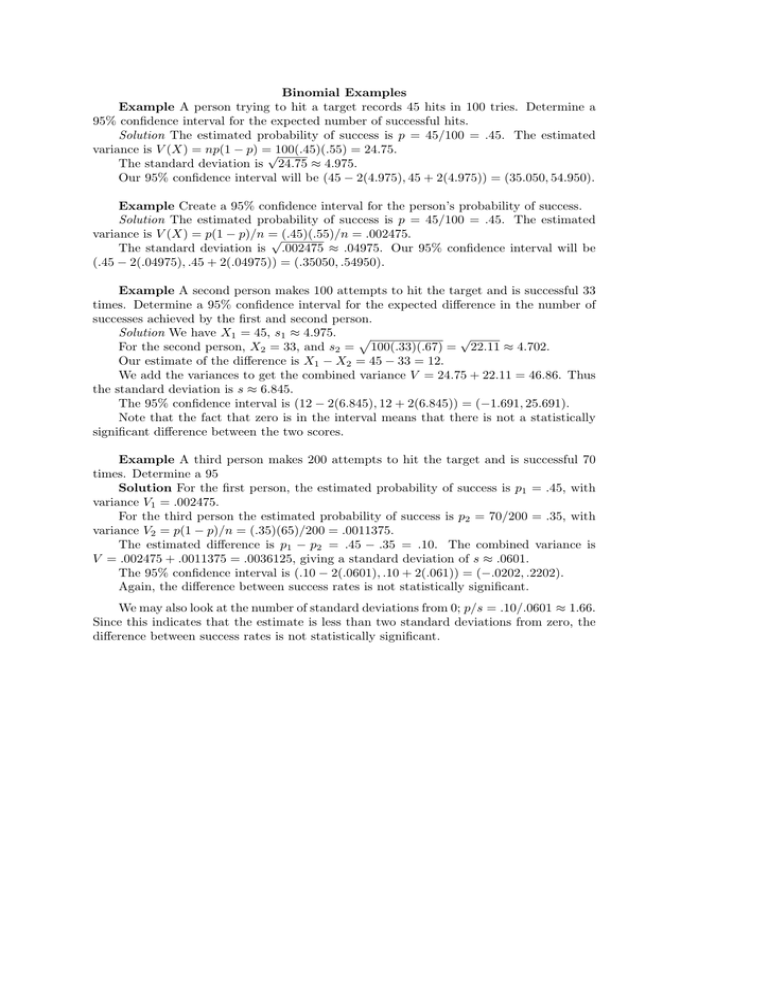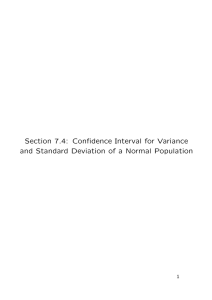Binomial Examples
advertisement

Binomial Examples Example A person trying to hit a target records 45 hits in 100 tries. Determine a 95% confidence interval for the expected number of successful hits. Solution The estimated probability of success is p = 45/100 = .45. The estimated variance is V (X) = np(1 − p) =√100(.45)(.55) = 24.75. The standard deviation is 24.75 ≈ 4.975. Our 95% confidence interval will be (45 − 2(4.975), 45 + 2(4.975)) = (35.050, 54.950). Example Create a 95% confidence interval for the person’s probability of success. Solution The estimated probability of success is p = 45/100 = .45. The estimated variance is V (X) = p(1 − p)/n = √(.45)(.55)/n = .002475. The standard deviation is .002475 ≈ .04975. Our 95% confidence interval will be (.45 − 2(.04975), .45 + 2(.04975)) = (.35050, .54950). Example A second person makes 100 attempts to hit the target and is successful 33 times. Determine a 95% confidence interval for the expected difference in the number of successes achieved by the first and second person. Solution We have X1 = 45, s1 ≈ 4.975. p √ For the second person, X2 = 33, and s2 = 100(.33)(.67) = 22.11 ≈ 4.702. Our estimate of the difference is X1 − X2 = 45 − 33 = 12. We add the variances to get the combined variance V = 24.75 + 22.11 = 46.86. Thus the standard deviation is s ≈ 6.845. The 95% confidence interval is (12 − 2(6.845), 12 + 2(6.845)) = (−1.691, 25.691). Note that the fact that zero is in the interval means that there is not a statistically significant difference between the two scores. Example A third person makes 200 attempts to hit the target and is successful 70 times. Determine a 95 Solution For the first person, the estimated probability of success is p1 = .45, with variance V1 = .002475. For the third person the estimated probability of success is p2 = 70/200 = .35, with variance V2 = p(1 − p)/n = (.35)(65)/200 = .0011375. The estimated difference is p1 − p2 = .45 − .35 = .10. The combined variance is V = .002475 + .0011375 = .0036125, giving a standard deviation of s ≈ .0601. The 95% confidence interval is (.10 − 2(.0601), .10 + 2(.061)) = (−.0202, .2202). Again, the difference between success rates is not statistically significant. We may also look at the number of standard deviations from 0; p/s = .10/.0601 ≈ 1.66. Since this indicates that the estimate is less than two standard deviations from zero, the difference between success rates is not statistically significant.





